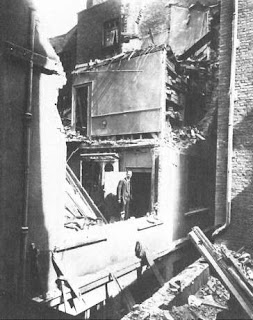We set off down Gate Street and into Lincoln's Inn Fields, going into the central paved area of the fields. Our first proper port of call was in New Square, but Aly didn't want to been seen to disturb any of the many law firms or chambers situated there, so decided to give us a brief background to today's walk. World War I was the first war fought partly in the air. It began in 1914 and fighting on the Western Front was between Germany and Austria against England and France, much of which was fought in the trenches. Before this war balloons had been used during the U.S. Civil War in the 1860s for reconnaissance and also during the Franco-Prussian War of the 1870s, but in 1900 all this changed when the first dirigibles appeared (which could be steered via four engines, one of each side, in any direction).
It was Ferdinand Von Zeppelin, a German army officer, who began developing his ideas on airships in 1897. His first 'Zeppelin' flew on 2nd July 1900. In March 1909 the LZ-3 was accepted into army service and by the start of WWI the German army had seven military airships. A new ship designed in 1914 could reach a maximum speed of 136 kph and reach a height of 4250 metres. It carried five machine-guns and could carry 2000kg of bombs (that's 4,400 lbs!). The airships were filled with Hydrogen, which is of course highly flammable, and when during 1915-16 new biplanes with front guns and incendiary devices were introduced, the zeppelins became increasingly vulnerable to being shot down. After 1916 they were no longer cost effective and Germany turned to the new Gotha bombers. These were countered by the Sopwith Camels which were very adept at shooting down these bi-planes.
Anyway, we now walked on across the Fields and through the large gateway to Lincoln's Inn and New Square, turning left towards Stone Buildings and stopping outside No. 10. Here we found a plaque which read as follows:

"The round stone in the middle of the roadway marks the spot where, on 18th December 1917 at 8 - 10pm a bomb from a German aeroplane struck the ground and exploded, shattering the windows in Stone Buildings and doing other material damage".
The round stone is no longer there, but the considerable damage to the stone of the buildings here can still be seen. It was thought that to leave the damage unrepaired would show a defiance to carry on in the face of war. Fourteen people were killed and eighty five injured in this attack, by a Gotha.
We now walked up into Chancery Lane, across High Holborn and turning left continued on until we turned right into Red Lion Street and continued down to the Dolphin Tavern.
 Originally a Victorian pub, approximately half had to be rebuilt following a Zeppelin raid on 9th September 1915. Inside on the wall is an old clock under which is a plaque which states:
Originally a Victorian pub, approximately half had to be rebuilt following a Zeppelin raid on 9th September 1915. Inside on the wall is an old clock under which is a plaque which states:"Hit by explosive bomb dropped from Zeppelin L.13 on 9th September 1915. 3 men were killed. The old clock was recovered with the hands stopped at 10.40 pm, the time the tavern was hit."
The raid dropped a series of bombs in a line from Euston to Liverpool Street and it was the same raid that also hit our next stop.
We walked on up to Theobalds Road turning left, and right down into Boswell Street and along to Queens Square.
Towards the far end of the gardens a plaque is set into the grass which reads:

"On the night of the 8th September 1915 a Zeppelin bomb fell and exploded on this spot. Although nearly 1,000 people slept in the surrounding buildings no person was injured."
During this raid a Leutnant Heinrich Matte was killed when his Zeppelin came down in Potters Bar. A piece of metal from the wreckage was used to make an altar piece for the Church of the Virgin and All Saints in that town.
We now left the gardens and walking through Cosmo Place came to Southampton Row. We crossed the road to the Bedford Hotel where we found another plaque. This one reads:

"24 September 1917. 13 people were killed and 22 injured near this spot on the steps of the old Bedford Hotel by a 112 lb bomb dropped by a Gotha in one of London's first night air raids. "
In this raid over London and the South East a total of 21 people were killed and a further 48 were injured.
The Germans used 115 Zeppelins and carried out approximately 150 Zeppelin raids during WW1. 77 of these were either destroyed or so damaged they could not be used again. Altogether Zeppelins caused 557 deaths, but the cost of building them was nearly five times as much as the cost of damage caused. No bombing raids using Zeppelins were carried out over London after June 1917.
The Zeppelin raids forced Britain to use Royal Flying Corps squadrons to protect London and so they were less actively involved in the war over the trenches. Holborn was one of the most densely hit areas during WW1.








1 comment:
What a fantastic exploration of first world war damage in London! I live near The Dolphin, it's a great little pub (-:
Post a Comment